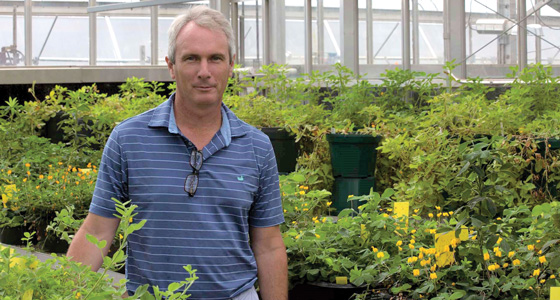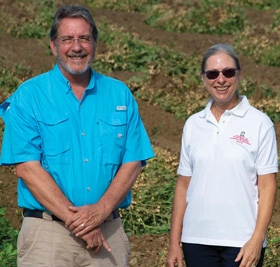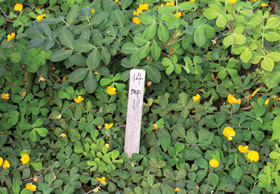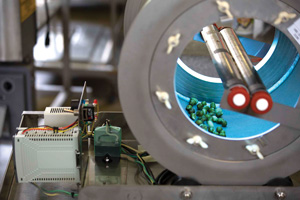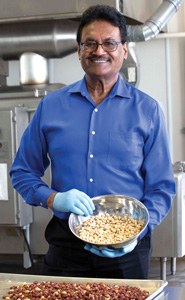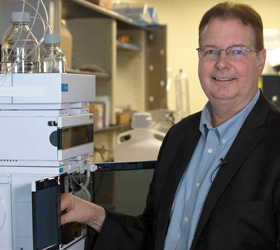
The Most Important Nut Is a Legume: The Peanut
Researchers at the University of Georgia ensure that peanuts stay plentiful and powerful.
Article Content
Atlanta has more than 70 streets with “peach” in the name. This seems to imply that peach trees are the most significant agricultural crop in the state of Georgia; they are not. The most important agricultural crop in Georgia is peanuts; they are the state’s fourth-largest agricultural commodity. Georgia produces more peanuts than any other state in the nation and is home to some of the best peanut researchers on the planet: Scientists at the University of Georgia (UGA) are integral to the production of peanuts in the state, which produces about 50% of the U.S. peanut supply. Their research improves the safety, sustainability, profitability, and affordability of peanuts not only in Georgia but also around the world.
The peanut—known in most other countries as the groundnut—was introduced to North America in the 1700s, but it was not commercially grown in the United States until the 1800s. Because of the research of George Washington Carver, the peanut became one of the crops that helped save and grow agricultural development in the South, where soils had been depleted of nitrogen because southern farmers had heavily relied on growing cotton. Despite its early contribution to agricultural development, in many ways, the peanut is just beginning to receive the accolades it deserves. “Peanuts are important in the [United States], particularly in the Southeast,” says Scott Jackson, a professor in the Department of Crop and Soil Sciences at UGA and director of the university’s Center for Applied Genetic Technologies. “[The peanut] is a major part of the agricultural portfolio in the state of Georgia; thus, it is a major part of the research portfolio at the University of Georgia.” UGA’s extensive research on peanuts has led to many discoveries about the peanut’s nutrient value, food applications, crop production and yield, genetic roots and potential, pest and pathogen control, and allergenicity. Basically, UGA’s peanut research covers everything from breeding and selection to growing and harvesting to processing.
Selecting and Breeding the Perfect Peanut
Farmers plant peanut kernels in the sandy soils of Georgia during April or May. About 10 days after planting, seedlings begin to emerge and eventually grow into green oval-leafed plants. About 40 days after planting, small yellow flowers appear on the plants. Although peanut plants flower above ground, their fruits (i.e., peanuts) grow below ground, so the flowers pollinate themselves, then undergo a transformation: Their petals fall off as fertilized pegs (i.e., ovaries) form; the pegs grow downward away from the rest of the plant and into the soil. And if all goes well, the peanut develops underground. But before any of that can happen, plant breeders utilize genetics and genetic technologies to develop seeds with good potential. “Genetics is understanding the inheritance of traits. This goes all the way back to Mendel in the 1800s,” Jackson explains, and “molecular genetics is simply … understanding what genes control those traits and how those genes are organized and how they are regulated.” Genetics empowers agriculture to provide a highly diverse food supply that meets the needs of a changing world, introducing new ways to increase crop yields, improve the nutritional value of crops, enhance their tolerance to insects and diseases, and feed the world. “Studying the genetics of crops and mapping their genomes is important to agriculture because … we have a growing global population, and in order to feed that population we have to improve the productivity of the plants that we grow,” says Peggy Ozias-Akins, a professor in the Department of Horticulture at UGA and director of the university’s Institute of Plant Breeding, Genetics, and Genomics. “There’s only so much arable land in the world, and we’ve already essentially used all of that arable land. So we really have to improve crop productivity—of course, while maintaining the nutritional content and also satisfying consumer preferences.”
At UGA, genetics and gene-editing tools enable plant breeders and other scientists to develop peanut plants that are best-suited to Georgia’s environment. “[With] traditional breeding, you get between 1% and 3% annual increase in yield,” Jackson asserts. “Understanding the genes that control yield, the genes that control how a plant responds to an environment, understanding the genes that control how a plant responds to different stresses like a fungus, virus, insects, heat, drought, or too much water will allow us to engineer plants that are better adapted to a broader range of growing environments, will yield better, and—importantly—will be more nutritious for the people who consume these plants.” Armed with genetic information down to molecular details, UGA plant breeders develop peanut plants that will be highly productive in the face of all sorts of adversities. “Basically, once we understand all of the genes in a genome and how they contribute to the development and the form and the function of a plant, the more efficiently we can go about actually modifying those genetics to improve plant productivity as well as nutrition and taste perhaps,” says Ozias-Akins.
To get an elevated understanding of how to improve the peanut plant and optimize its production in Georgia, UGA scientists first had to identify all of the plant’s genes. Ozias-Akins and Jackson were part of a global team that completed the mapping and sequencing of the peanut genome in 2016. “The peanut genome is very complicated because it’s what we call a polyploid plant,” Ozias-Akins says. “It actually contains more than two sets of chromosomes—four sets, it’s tetraploid. In addition to being polyploid, it also is a relatively recently formed polyploid in terms of evolution. The two progenitors that hybridized to create cultivated peanut are very similar to one another in terms of their DNA sequences.” Jackson concurs, adding, “Genomes are comprised of four letters: A, C, T, and G. In peanut, there’s about 2.5 billion A, C, T, and Gs in its genome, so that’s a lot of A, C, T, and Gs. For context, a human has about 3 billion A, C, T, and Gs; so we’re not that much more complicated than a peanut, you might say.” After six years of work, Jackson, Ozias-Akins, and the rest of the global team had sequenced not only the genome of the cultivated peanut but also the genomes of its parent plants. “I think the importance is that now we have a better understanding of the genes that make up peanut,” Jackson says. “This allows us in the future to be able to engineer the peanut to be more productive, to be more resilient against climate changes or variability, to be resistant to various pathogens that attack it, and to engineer for quality."
Science That Improves the Peanut
Ozias-Akins and her research colleagues have used genetic engineering to improve the peanut in a variety of ways, including reducing the allergenicity of peanut, but none of those varieties are commercially available. “I have worked for many years with genetic engineering of peanut, initially with the thought to use it as one means to improve disease resistance in peanut. We actually were successful in doing that for tomato spotted wilt virus although those materials are not being used in cultivation at this point,” Ozias-Akins reveals, emphasizing that there is no genetically engineered peanut on the market. Ozias-Akins, Jackson, and other UGA scientists use genetic engineering only as a way to enhance conventional breeding through marker-assisted selection. “We’re using genetic engineering … to look at the function of genes or look at the function of candidate genes,” Ozias-Akins explains. “For example, using genome sequence and genetic mapping, if we identify a piece of DNA that is predicted to be a disease-resistance gene, but we really need to provide evidence that this is indeed functioning as a resistance gene targeting a specific pathogen, then we need to do other studies, often including genetic engineering, to see if that gene is really underlying the trait for resistance.” In essence, they use genetic engineering to speed up test breeding to determine more quickly whether a gene has a particular trait. Once they confirm that the gene has that trait, they use marker-assisted selection to find that piece of DNA and use it in conventional breeding. “Breeding is a numbers game. If you can reduce those numbers by early selection—in this case, using markers that we’ve already shown are associated with a particular trait—then you can greatly reduce the numbers that you have to take to the field to actually test for other traits, such as agronomic traits or production, and reduce the cost to the breeding program,” Ozias-Akins says.
Using marker-assisted selection, Ozias-Akins and her research colleagues have been able to improve varieties of peanuts that are commercially available. In the United States, there are four different market types of peanuts: Runner, Virginia, Spanish, and Valencia; each is distinctive in size, shape, and flavor. The most commonly grown peanut in Georgia is a Runner-type variety called Georgia-O6G, which was developed by UGA professor William Branch; it is a high-yielding peanut with large seeds and a high level of resistance to tomato spotted wilt virus. “In the early [1980s], there was a viral disease—tomato spotted wilt virus—that came into Georgia, and we were pretty much a monoculture of one cultivar at the time called Florunner. Florunner was very susceptible to tomato spotted wilt virus,” Ozias-Akins recalls. This means that the virus could have wiped out Georgia’s peanut production. “As it turned out, there were breeding programs already working with improving cultivars, and some of those genetic materials, when they were tested in the field, showed resistance to the virus. Therefore, they were used to develop cultivars that had that genetic resistance because there’s no way, really, to control that virus with chemicals.” There are many other pests and pathogens that can attack the peanut plant: Some attack the peanut plant while it is growing; others attack after its peanuts are harvested and stored. “There’s pests and pathogens that can attack peanuts during growth that will limit the yield: viruses, fungi, and different insects (aphids and so forth) that reduce the yield potential of the peanut,” Jackson says. “The major one that we think about causing problems downstream of growth is aflatoxin.”
Aflatoxin is a mycotoxin produced by the fungi Aspergillus flavus and Aspergillus parasiticus. Aspergillus flavus and Aspergillus parasiticus can grow on many foods but are predominantly seen on corn, tree nuts, and peanuts growing in tropical and subtropical geographic areas. The presence of either fungus on peanuts does not necessarily mean the peanut is contaminated with aflatoxin. Damage from insects and extreme environmental stressors also play a role in whether peanuts and other crops are contaminated with aflatoxin. “It’s a complex interaction between the fungus and the plant and the environment [that] trigger[s] the production of [aflatoxin],” Ozias-Akins says. “The fungus can be present in peanut seed, for example, but not actually produce the toxin until it’s probably detecting a stress response of the plant perhaps due to drought [or] perhaps due to elevated temperature and that then triggers the aflatoxin production.” In the United States, there are strict regulatory procedures for growing, harvesting, and storing peanuts that reduce the risk of consumers being exposed to aflatoxin in U.S. peanuts. But in developing countries, aflatoxin-contaminated peanuts are a significant problem. “When we store peanuts, we can control the climate and those conditions to reduce the possibility of contamination by aflatoxin,” Jackson says. “In other parts of the world, they don’t have that technology. They don’t have the energy to run those warehouses. So it’s more of a problem in those parts of the world.” Jackson, Ozias-Akins, and other UGA researchers have been working with researchers around the world to develop peanuts that are resistant to preharvest aflatoxin contamination. The recently completed sequencing of the peanut genome is very helpful in this regard. “We’ve been working on genetic resistance for aflatoxin contamination for many years,” Ozias-Akins reveals. “We have made progress in making selections for lines that do have reduced levels of aflatoxin contamination. We’re looking both preharvest with what we call the rain-out shelters, but we’re also doing some postharvest studies because we know that there can be an increase in aflatoxin contamination in stored products.” With this project, UGA researchers are working to improve the quality and yield of peanuts grown around the world as well as those grown in Georgia.
Processing the Peanut
After the optimally bred peanut plants successfully complete their 135- to 145-day growing season, the peanuts are harvested and processed. Peanuts that will be processed into peanut butter or used in other foods are shelled, blanched to remove the skins, and roasted. UGA scientists are investigating ways to blanch and roast peanuts more efficiently. “The physical advantage of blanching [peanuts] is to make sure the peanut kernel is more stable because the red skin will cause problems for products,” says Rakesh Singh, a professor and head of the Department of Food Science and Technology at UGA. “[Blanching] also inactivates the enzyme called polyphenol oxidase, which may cause further degradation of the kernel’s surface. So blanching is done to remove the red skin and preserve the peanut.” Blanching can be achieved in various ways, including dry blanching, in which peanuts are exposed to a temperature of 138°C for 30 minutes or more; water blanching, in which the skins are loosened by spraying peanuts with hot water; or spin blanching, in which peanut skins are loosened with steam and removed by spinning. In his laboratory, Singh and his research team have developed a blanching technique using infrared heat and are working on a process that will reduce aflatoxin contamination on peanuts. “We are doing some work in which we are combining hydrogen peroxide treatment with UV radiation to see if we can reduce aflatoxin contamination,” Singh discloses. “People have done a lot of other chemical treatments as well as physical treatments to reduce aflatoxin. We are also setting up a cold plasma treatment (down the road) to see [whether] that will reduce aflatoxin.”
After being blanched and roasted, peanuts can be further processed into a number of food products, including boiled peanuts, peanut butter, candies, and peanut oil. “Georgia peanuts go for everything!” Singh exclaims. More than 50% of Georgia’s Runner peanuts are used to make peanut butter; the rest are used for snacks, candy, and peanut oil. Georgia designated the peanut as its official state crop in 1995, so the peanut is held in high esteem there. In fact, peanuts are popular all across the United States because “they taste good; people like them,” Singh says. Not only do peanuts taste good; they are good for human health.
Nutrient Density of the Peanut
The peanut provides a remarkable combination of nutrients and bioactive compounds that makes it one of nature’s most nutrient-dense foods. “The peanut is a great plant-based source of protein. Peanuts contain somewhere around 24% to 26% protein,” says Ronald Pegg, a professor in the Department of Food Science and Technology at UGA. Peanuts contain more protein than almonds, walnuts, pistachios, pecans, and other tree nuts. “They contain about 50% lipids; most of them are made up of about 83% of a combination of oleic and linoleic acids, which are the mono- and polyunsaturated fatty acids,” Pegg adds. “In fact, we also have a class of peanut called high-oleic peanuts, which are bred specifically to maintain a high oleic-acid content of around 80%. These are very popular [with] the candy industry because they have great shelf-life stability.” Monounsaturated fats, which constitute at least half of the unsaturated fats in peanuts, are said to help lower low-density lipoprotein levels in the blood and lower the risk of heart disease. Therefore, peanuts, peanut butter, and peanut oil have a high content of the types of fats that raise high-density cholesterol, reduce low-density cholesterol, and thereby reduce the risk of heart disease. Besides protein and heart-healthy lipids, peanuts also contain fiber. In fact, more than one-third of the carbohydrates in peanuts is fiber, which helps improve digestion, slows absorption of certain nutrients, and also lowers the risk of cardiovascular disease.
Peanuts are recognized as an excellent source of vitamins (especially folate, niacin, and vitamin E), minerals, and certain bioactive compounds. “Peanuts are quite rich in terms of their phenolic acids [such as] para coumaric acids. Some research has shown that they may contain some resveratrol, which is called a stilbene. They contain important proanthocyanidins (what we call PACs), which are flavan-3-ols,” Pegg says. And one of the most interesting bioactive compounds in peanuts is arginine. “[Arginine] is a natural component found in peanuts at a very high level,” Pegg continues. “That’s quite important because arginine, when it is metabolized, can produce a very important molecule called nitric oxide, which is a potent vasodilator.” Nitric oxide is a molecule that is integral for human health because it maintains the health of blood vessels, lowers blood pressure, protects against heart attack and stroke, regulates gut motility, acts as a neurotransmitter in the brain, and plays a role in the apoptosis of cancer cells. Most (if not all) cardiovascular disorders and chronic diseases are related to the loss of nitric-oxide production, so the peanut’s high content of arginine is another reason to view peanuts as a heart-healthy food.
The peanut is therefore beneficial to humans as well as for the earth, which perhaps makes it the most important “nut” (even though it is a legume) in existence. With all the beneficial characteristics of peanuts, it is clear that the work of UGA’s peanut researchers has an essential purpose: It helps ensure that the peanut survives any adversities that come its way and continues to nourish the bodies of consumers all over the world.
Toni Tarver is senior technical editor of Food Technology ([email protected]).



